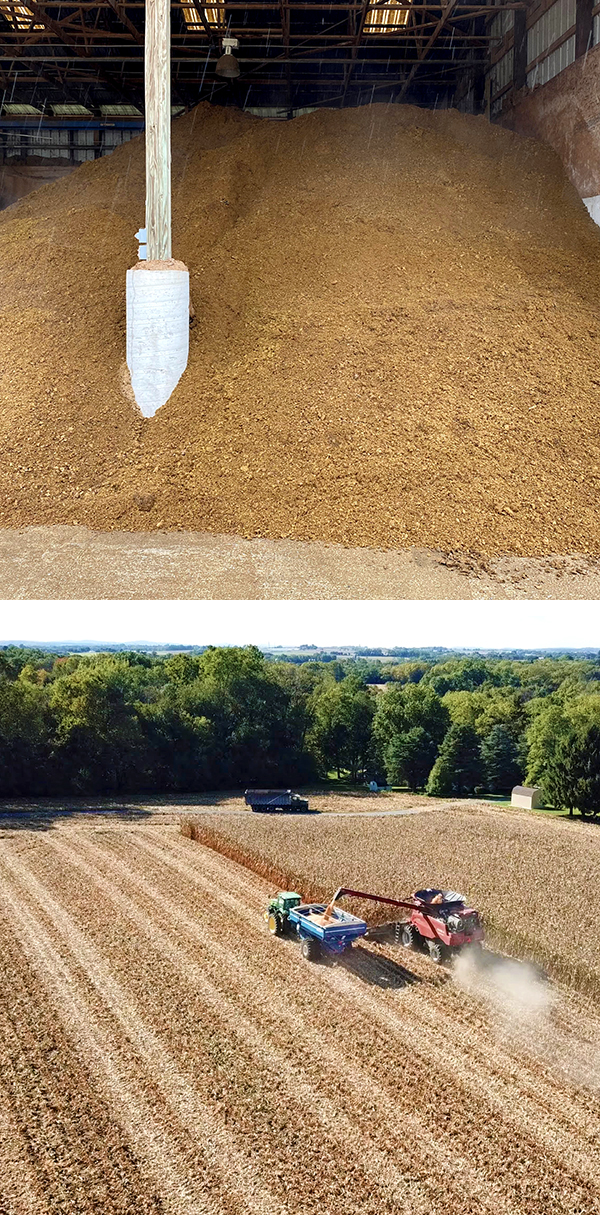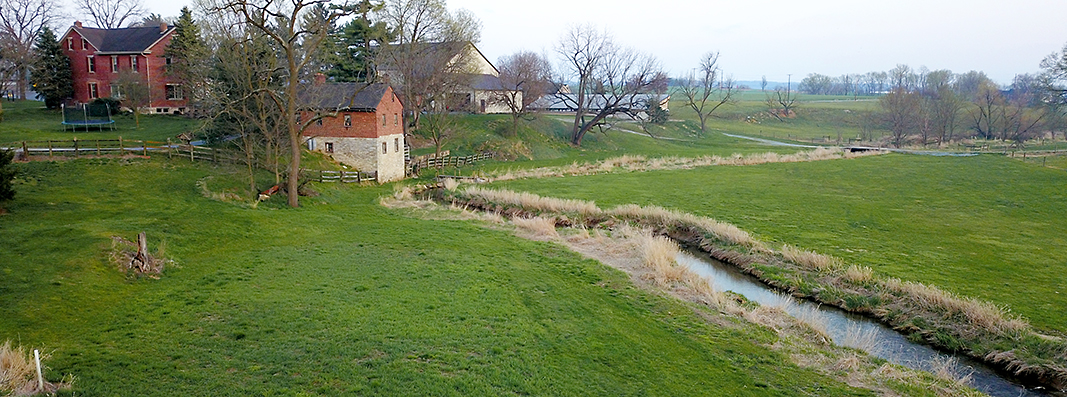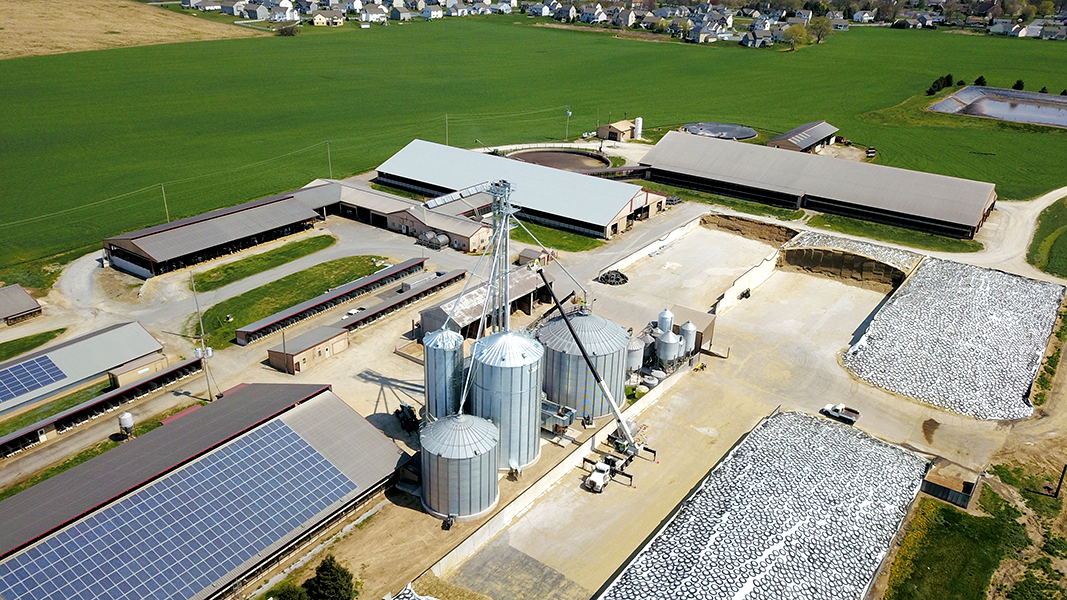Top: Aerial view of Brubaker Farms shows its proximity to residential developments. Photos by Rachel Simmons
Nora Goldstein
Brubaker Farms in Mount Joy (Lancaster County), Pennsylvania is home to 1,300 dairy cows and 52,000 broiler chickens. With residential developments bordering its 1,800 acres, the farm is located where the rural-urban interface occurs — and thus odor management and protecting water quality are paramount.
BioCycle profiled Brubaker Farms in 2011, four years after it had installed an RCM digester to manage its dairy manure. In addition to energy production, benefits from installing the anaerobic digester include nutrient management (nitrogen and phosphorous), odor control (odors were reduced by about 90%), and use of the separated digested solids as bedding for the dairy cows. Previously, the cows were bedded on sawdust at a cost to the farm of $1,000 a load. About half of the bedding is used by the Brubakers, and the other half is sold to other dairies.

Top: Separated digested solids (top) are utilized for bedding the dairy cows. Bottom: Digested liquids are land applied on the farm to produce a variety of crops, all mostly used for feed.
The digested liquids are land applied on the farm to produce corn, soybeans, rye, wheat and grass hay, all mostly used for feed. “We do not need to purchase any phosphorus or potassium as that is supplied by the digestate,” explains Mike Brubaker, whose family started dairy farming in 1929. “The nitrogen available reduces the amount of extra nitrogen that we need to purchase.”
The Brubakers were early adopters of soil health and nutrient management practices. Their land and watershed stewardship was recognized recently when the farm received the 2021 Pennsylvania Leopold Conservation Award® given in honor of conservationist Aldo Leopold. In Pennsylvania, the $10,000 award is presented annually by Sand County Foundation, American Farmland Trust, The Heinz Endowments, and Pennsylvania Farm Bureau. The award recognizes farmers, ranchers and forestland owners who “inspire others with their dedication to land, water and wildlife habitat resources in their care.” This ethic has been passed on to Josh Brubaker, Mike Brubaker’s son, who recently became the fourth generation with a stake in the farm’s ownership.
“The Brubaker family provides us with a comprehensive example of how farmers build upon their environmental stewardship successes,” said Pennsylvania Farm Bureau President Rick Ebert, when presenting the Award at the Pennsylvania Farm Show in January 2022. “The Brubaker’s commitment to being good stewards and good neighbors shines through in the overall success of their dairy and poultry farm.”

To protect surface and groundwater quality, the Brubakers fenced cattle away from streams and planted trees in 15 acres of riparian buffers.
Much of the farm is in a wellhead protection area, which means its soil filters rainwater that eventually provides drinking water from their neighbors’ wells. To protect water quality, the Brubakers plant cover crops each year and practice no-till farming. With credits earned for their innovative cropping practices, Brubaker Farms was among Pennsylvania’s first farms to trade nutrient credits with local wastewater treatment plants. With assistance from the federal Conservation Reserve Enhancement Program, they fenced cattle away from streams and planted trees in 15 acres of riparian buffers. Installation of the anaerobic digester in 2007 improved the farm’s ability to store, handle and apply manure in ways that help minimize its environmental impact while maximizing its economic value as fertilizer. The digestate is “dragline applied” on 500 acres, which prevents soil compaction from large manure spreading equipment, and it keeps heavy, noisy equipment off of local roads. When the Brubakers began milking cows at a secondary location, they installed a buried pipeline to transport manure to the main dairy where the digester is located.
AD Operations, Renewable Electricity
About 40,000 gallons/day of manure is fed to the digester, almost double the amount since 2011. The Brubakers experimented with digesting the poultry litter. “It makes a lot of methane, however we felt it added ammonia to the digested solids that we use for cow bedding, so we stopped trying it,” notes Brubaker.”Instead, we compost the chicken manure in a windrow in the chicken houses between flocks, and then sell the compost.” Raw dairy manure is held in a 25,000-gallon reception pit; another 25,000-gallon pit holds digestate before it goes into the solids separator.
In 2009, Brubaker Farms began receiving pulped food waste and fats, oils and grease (FOG) from the cafeteria at Elizabethtown College, located nearby in Elizabethtown (PA). Six to eight toters a week (each weighing about 200 lbs) are tipped into a 25,000-gallon food waste reception pit. “We also take rejected milk from other area dairies,” he adds. “Initially, we accepted food processing residuals, but had to stop due to filling the digester capacity with an increased amount of dairy manure in the last 10 years.”
The farm has a 335 kW Guascor/Seimens engine generating about 335 kW/hour of electricity that is fed onto the grid under a net metering arrangement with PPL Electric Utilities. It also has rooftop solar panels that generate 285 kW/hour of electricity that is sold to PPL. Waste heat from the engine is used to heat the digester, as well as several buildings, including the milking parlor.
With decades of soil and water stewardship under their belt, the Brubakers encourage other farmers to adopt similar practices to reduce nutrient and sediment runoff into Pennsylvania’s waterways. “Start working on the low hanging fruit first,” says Brubaker. “Install conservation BMPs (Best Management Practices) that have the most economic value first. Then keep adding more practices that have environmental and economic value as you become more comfortable with them. Partner with people and organizations that have practical wisdom and expertise in helping implement practices.”












